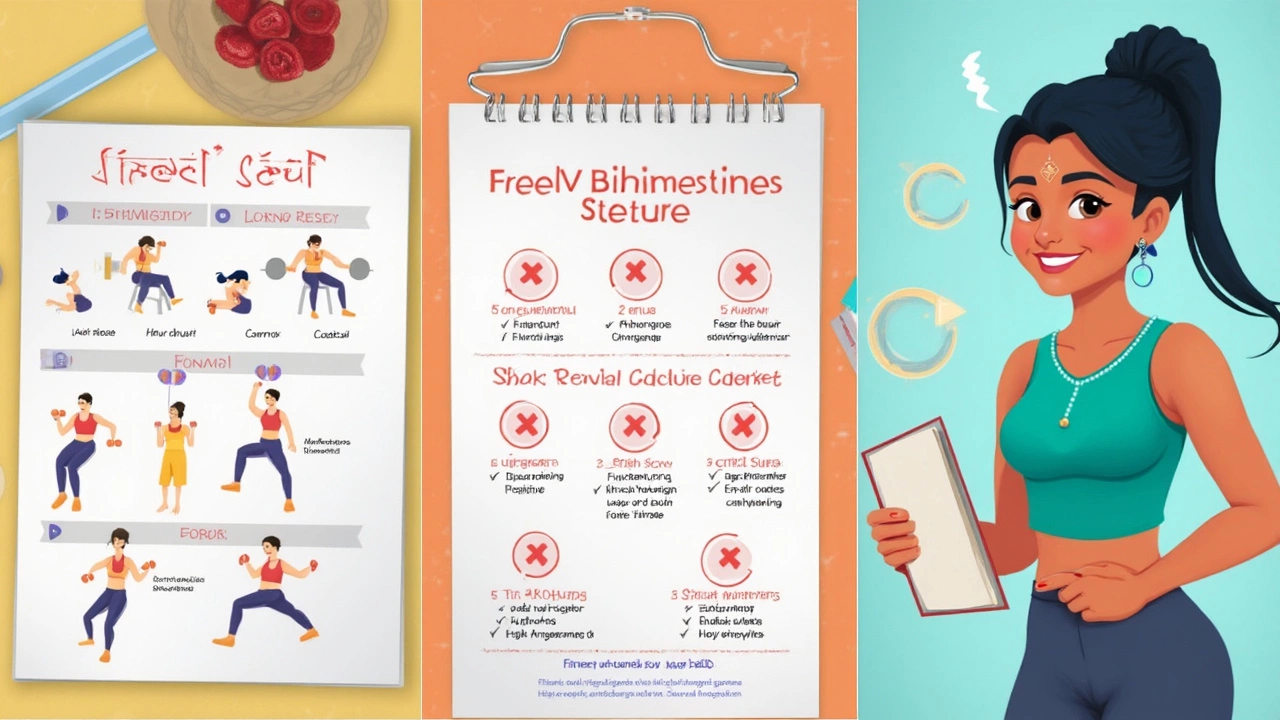How Often Should a 55 Year Old Lift Weights? The Real Answer Might Surprise You
 May, 27 2025
May, 27 2025
If you're 55 and thinking about lifting weights, here's what matters: you're not too old, and you don't need to spend hours at the gym. The trick is getting the right balance—enough work to see results, not so much you overdo it. Sticking to a routine just two or three days a week is often the sweet spot for most people in their 50s.
Muscle loss really ramps up after 50 if you don't challenge your body. That annoying struggle with opening jars? It's usually less about age and way more about fading muscle strength. Lifting weights can slow this down—sometimes even reverse it. And no, it doesn't mean bulking up (unless you want to). Think of it as building insurance for your movement, your bones, and even your mood.
Wondering if you need fancy equipment? Not at all. Bodyweight exercises, resistance bands, or simple dumbbells are enough to kick off an effective plan. The main thing? Consistency and listening to what your body is telling you—soreness is normal, sharp pain isn’t. And yes, you can absolutely start, even if you haven’t touched a dumbbell since high school gym class.
- Why Weightlifting Matters After 55
- How Many Days Per Week Works Best?
- Choosing the Right Program for Your Body
- Safety First: Tips for Injury-Free Progress
- Realistic Results: What to Expect Month-by-Month
Why Weightlifting Matters After 55
If you just hit your mid-50s, your body acts way differently than it did at 35. By age 55, we’ve already started losing muscle—about 1% every year if you don’t do anything. That’s a big deal because muscle isn’t just about looking fit; it’s about staying independent and injury-free. Strong muscles make everyday stuff like carrying groceries, climbing stairs, or getting up off the floor way less of a struggle.
Now, here’s the reality: adults over 50 are at much higher risk for falls and broken bones. Weightlifting helps build not just muscle, but bone strength. Studies from the National Institutes of Health show regular strength training can bump up bone density, slashing the risk of osteoporosis.
And there’s more. People who lift weights in their 50s usually manage blood sugar better, have healthier joints, and even sleep better at night. The benefits go past the mirror—lifting weights can lower anxiety, improve mood, and sharpen memory, thanks to a nice boost in brain-friendly hormones.
- Just 2–3 sessions a week cuts the risk of type 2 diabetes by nearly a third, according to a Harvard study.
- Strength training twice weekly helps maintain balance, reducing fall risk by about 40% in seniors, says CDC data.
- It also keeps metabolism higher—meaning it’s easier to keep stubborn weight from creeping up each year.
Check out the simple stats below; they drive home why getting serious about resistance training makes such a difference after 55:
| Benefit | How Much Improves (On Average, Per Year Lifting) |
|---|---|
| Muscle strength | Up to 30% gain in first 12 months |
| Bone density | 2–5% increase for women, 1–3% for men |
| Metabolic rate | Approx. 7% higher |
| Risk of falling | Cuts fall risk by 20–40% |
So if you’re asking why bother with weightlifting at 55? The real question is—why not?
Start simple, but start. Even just a handful of moves done regularly will deliver a major return on effort. The secret’s not fancy gear or super-heavy weights. It’s about doing it often enough to stay ahead of muscle and bone loss, stay limber, and keep rocking the things you love.
How Many Days Per Week Works Best?
This is where people often get stuck. How often do you really need to lift to see changes at 55? Not every day—that’s for sure. You actually get better results with proper rest between sessions because your muscles rebuild and grow stronger during downtime.
Most experts agree: for most people over 50, the sweet spot for lifting weights over 50 lands right at 2 to 3 days a week. The American College of Sports Medicine recommends adults over 50 work each major muscle group twice a week. This isn’t just fitness fluff—it’s based on years of research looking at muscle retention, injury rates, and overall well-being.
"Allow at least 48 hours between each session to let your muscles recover—recovery isn’t a luxury; it’s where the magic happens." — Dr. Wayne Westcott, professor of exercise science, Quincy College
Here’s a glance at what you can get out of different routines:
| Days per week | Expected Benefits | Risk Level |
|---|---|---|
| 1 | Basic maintenance | Low |
| 2 | Steady strength gains, bone support | Low to Medium |
| 3 | Faster muscle growth, improved metabolism | Medium (watch recovery) |
| 4+ | Possible burnout or injury if recovery is ignored | High |
Most folks do best with either a Monday-Wednesday-Friday setup or picking two non-consecutive days like Tuesday and Saturday. This way, you stay consistent, but your muscles get proper rest so you’re not always sore and tired. If you want to do more than three sessions, be extra sure you’re not doubling up on the same muscle groups, and check in with your body—fatigue and nagging pain are warning signs to pull back.
Quick tip: Some people like to add light walks, yoga, or mobility work on the off days. That’s great, just keep the heavy stuff to two or three main lifts each week. Again, it’s about quality, not quantity. Your body will thank you for finding the right mix.

Choosing the Right Program for Your Body
Your body at 55 isn’t the same as it was at 25, and your workout shouldn’t be either. The idea isn’t to do the hardest thing possible, but to pick something you’ll stick with and that matches where you’re at today. A lot of people think they need to smash out five days a week, but honestly, going two or three days with full-body sessions works better for most folks in this age group. This gives your muscles recovery time and helps you avoid burnout or injuries.
Let’s talk about what a typical week can look like:
- Two to three strength sessions per week, with at least a day of rest or light activity between sessions.
- Each session should target all major muscle groups—think legs, back, chest, shoulders, arms, and core.
- Most sets are in the 8–12 rep range; that’s ideal for building muscle without risking heavy strain.
Worried you’ll overdo it? Studies from the American College of Sports Medicine show that older adults gain the most from moderate intensity—weights that feel challenging by your last two reps, but not impossible. And yes, you can build muscle at 55 and beyond, especially if you challenge yourself gradually.
Here’s a simple table as a guide for what those first few weeks might look like, based on research from Mayo Clinic and AARP (2024):
| Week | Workout Frequency | Target Sets (per muscle group) | Rest Days |
|---|---|---|---|
| 1-2 | 2x/week | 1-2 | 2+ between |
| 3-4 | 2-3x/week | 2 | 1-2 between |
| 5+ | 3x/week | 2-3 | 1 between |
If you’re totally new to strength training 55 years old routines, start with just bodyweight moves like squats, pushups (on an incline if needed), or simple step-ups using a sturdy chair. Then, after a couple of weeks, add some weight or resistance bands. Keep sessions around 30-45 minutes. And don’t skip warming up—five minutes of light cardio or just moving the joints through their range helps keep injuries off the table.
Bottom line: the "best" program is one you can keep doing for months, not just weeks. Adjust as you go. If a workout leaves you drained instead of energized, it’s totally okay to dial it back. Progress isn’t about perfection—it’s about staying in the game and making tiny bits of improvement over time.
Safety First: Tips for Injury-Free Progress
No one wants to get sidelined by a sore back or tweaked shoulder, especially at 55 when bouncing back takes longer. The good news? Most common gym injuries can be easily avoided with a few smart habits. Here’s what really helps keep things safe as you build strength.
- Always Warm Up: Stiff joints and cold muscles are injuries waiting to happen. A 5-10 minute warmup—like walking or gentle cycling—gets blood flowing, makes you less likely to pull or strain something.
- Focus on Good Form, Not the Heaviest Weight: Ego lifting is a fast track to trouble. Good form means controlled movements, full range of motion, and not using momentum to swing the weight around. If you’re unsure, check your form in a mirror or ask a trainer to look at your moves.
- Rest Between Workouts: Muscles need time to recover, especially as we age. Hitting the same muscle group too hard two days in a row ups your risk of injury. Most people see the best results with at least one rest day in between sessions.
- Pain Isn’t Gain: Mild soreness is normal, sharp pain is a red flag. If something doesn't feel right, stop and check your technique—or see a medical pro if pain lingers.
- Pay Attention to Medications: Blood thinners or other meds can change your injury risk. Always check in with your doctor before starting a new strength training 55 years old routine.
Let’s get specific. These body parts are most often injured in people over 50 starting weight training:
| Body Part | Common Causes |
|---|---|
| Shoulders | Lifting overhead with poor form, too-heavy weights |
| Lower Back | Twisting while lifting, rounding your back during deadlifts |
| Knees | Deep squats with weak muscles or poor alignment |
| Wrists/Elbows | Gripping too tight, locking joints during curls or pressing |
If you’re nervous about new moves, machines can be friendlier than free weights because they guide your path. Start light—if you can’t control a weight for 12 slow reps, it’s probably too heavy for now. Don’t forget to cool down with stretches; it’s a simple step that keeps you limber and helps muscles recover faster.

Realistic Results: What to Expect Month-by-Month
It’s natural to wonder if you’ll see any real change when you start lifting weights over 50. The truth is, results come in stages—and they’re not all about biceps. Here’s what’s realistic for a 55-year-old if you stick to lifting two or three times a week and eat pretty well:
| Timeframe | What You Might Notice |
|---|---|
| First 2-4 Weeks | Lifting feels awkward, but you’ll probably feel more alert, maybe even sleep better. Muscles start waking up. Soreness is common, but it settles after the first sessions. |
| 1-2 Months | You start getting the hang of the moves. Groceries feel lighter, and balance might improve. People often gain a little strength before they see big visual changes. |
| 3-4 Months | Now, you might see some muscle definition, especially in the arms and legs. You could notice more stamina on walks or when taking stairs. Bone density gets a boost—helping prevent fractures. |
| 5-6 Months | Daily activities seem easier. Your body feels firmer. There’s usually a reduction in aches, and blood pressure or cholesterol may improve, based on real science. |
| 6+ Months | This is where the magic happens. Consistency pays off with further muscle growth, less body fat, and everyday tasks feeling far less taxing. Blood sugar control gets better, too. |
If you like specifics, here’s a good nugget: one study in folks over 50 showed an average 30-40% increase in strength after about four months of regular training. Gains may be a bit slower than when you were 25, but they’re 100% still happening. Even if the scale doesn’t move much, you’ll likely lose some belly fat and gain muscle. Your jeans will fit better, and movements like standing up or carrying groceries will feel easier.
- Track progress with how many reps or weight you can handle, not just what you see in the mirror.
- Don’t panic if you plateau for a week—your body’s still adapting.
- Remember, missing a workout here and there isn’t the end of the road. Just keep at it.
The best part is that you’re investing in a healthier, more independent future. Strength training over 50 isn’t about chasing youth—it’s about making the next decade a lot more enjoyable and a lot less limited.
